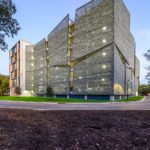
From humble sail-making beginnings, Structurflex has consistently pursued opportunities and developed new skills to become one of the world’s leading suppliers of innovative tensile membrane structures using coated PES, PTFE and ETFE fabrics. Our timeline tells the story of a company that’s always ready to embrace the next challenge.
Structurflex began life as Sails & Covers Ltd on 21 July 1937. Owned by Leo Bouzaid, the company designed and manufactured sails and other marine products for Auckland’s talented yachting fraternity. Auckland is often called ‘the city of sails’, because it has one of the highest rates of yacht ownership per capita in the world.
PVC (polyvinyl chloride) fabric technology was improving rapidly.
Recognising the future potential of the fabric, Leo Bouzaid purchased New Zealand’s first high frequency PVC welding machine for developing and manufacturing PVC products.
In 1962 Leo died and his two sons, Tony and Chris, took over the business. Both sons were world champions in yachting and brought their vision and determination to the business.
The polymer fabric side of the business grew substantially over the next 20 years.
Sails & Covers Ltd joined forces with the U.S. based international company Hood Sailmakers Inc. Hood took a 50% interest in the company, which was renamed Hood NZ Ltd.
The company was restructured and Structurflex was formed, as a subsidiary of the sail-making business. The new company focused on the design and manufacture of industrial products, such as truck covers, marker buoys, railway wagon covers and flexible containers.
From its inception, Structurflex was committed to creating innovative, cost-effective fabric structures using advanced production methods and engineering ingenuity.
Covertex was formed, as a subsidiary of Structurflex. Under the leadership of Matthew Bouzaid, grandson of the founder Leo Bouzaid, Covertex developed several new products including rapidly deployable structures, such as those used in conflict and disaster zones.
Structurflex moved to a purpose-built factory in Henderson and completed New Zealand’s first large tension membrane structure to cover the New Sunhill Garden Centre in Pakuranga, Auckland.
Structurflex fabricated and installed the tension membrane structure that covers the Olympic Pool in Papakura, Auckland. At the time, it was the largest air-supported structure in New Zealand.
Structurflex files a patent application for the ‘Tensioner 3’, a breakthrough for fabric and curtainsider tensioning devices.
Murray Higgs purchased Tony Bouzaid’s shares in Structurflex and joined the company as Marketing Director. Structurflex increasingly focused its attention on international opportunities.
Structurflex began exporting Flexisider curtainsiders, truck curtain hardware and oil booms to Malaysia.
Structurflex achieved ISO 9002 certification for quality systems. This certification provides quality assurance in production, installation and servicing.
Structurflex signed a joint venture agreement with Tan Chong Motor Holdings Bhd, Malaysia. One year later, Structurflex Sdn Bhd commenced manufacturing Flexisider curtainsiders in Kuala Lumpur.
Structurflex completed its first large tensile membrane structure in Asia, covering a large courtyard at the Hong Kong Institute of Education.
Structurflex completed its first major tension membrane structure in North America at HEB Monterrey, a large shopping center in Mexico.
Structurflex completed its first fabric architectural projects in the Middle East.
Structurflex Contracting Middle East LLC opened for business in Dubai to pursue growing demand for innovative tension membrane structures.
Structurflex LLC opens an office in Kansas City, to expand the fabric architecture business in North America. The office is responsible for marketing, design, engineering and installation.
Structurflex LLC establishes a joint venture with Nautika Ltda in Sao Paulo, Brazil to focus on the permanent fabric structure market.
Structurflex completes the first of many future fabric facade projects at Prairie Fire in Overland Park, Kansas, U.S.A. Since then fabric façades have become an important market segment for Structurflex in the USA.
Structurflex forms a joint venture with James Mizen to acquire New Zealand-based Fabric Structure Systems and Palmer Canvas. The new joint venture, SFS Holdings Limited, will strengthen the group’s architecture business and increase its capabilities in Northland, New Zealand.
Structurflex acquires Baytex, a business based in Mount Maunganui, New Zealand. Baytex is a leading designer and manufacturer of marquees, commercial tents, alloy framed structures, tensile membrane canopies, and lining systems.
Structurflex moves into its new North American Headquarters at 414 Oak Street in the historic River Market neighborhood of downtown Kansas City, Missouri. The new location includes design and fabrication facilities.
Tim McFadden is named as managing director for Structurflex (American Operations).
FlexFacades integrates public art into parking garage facades with the completion of two key Denver parking garages.
Structurflex moves into its new American headquarters in Merriam, Kansas.
The five-story, 60’s era West Hills Medical Office Building in Los Angeles was due for an exterior facelift. A complete exterior renovation by Michael W. Folonis Architects revealed that water infiltration had caused structural damage to the existing horizontal plaster awnings; removing them was a costly process that consumed much of the project budget. This […]

We are pleased to have collaborated with KieranTimberlake and the outfit of a parking structure on the Rice University Campus. In their blog post, they describe the concepts they employed to create an iconic sculptural element. For more details see the KieranTimberlake blog post.